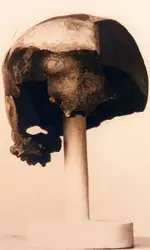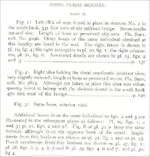This old chestnut again, which is based on misreported sensationalism not fact. The Smithsonian openly published letters from (usually amateur) ‘archaeologists’ making claims that they had found ‘giant bones’. They also then published follow-up reports after their regional and field geologists had assessed what was claimed. There isn’t a single instance where the claims for giant bones of
human origin could be substantiated. The ‘Vero Man’ story is typical of these kinds of false reports of giant mound builders and other similar claims.
From about 1913, large bones were noted in strata between Vero (its name changed to Vero Beach in 1925) and Gifford in Florida during construction of a drainage canal. These were later established to be fossil bones from large Pleistocene vertebrates, including very large mammoth bones. Giant maybe… but not
human giant. Misinformation was quickly spread by newspapers of the day with crowd-pulling headlines: “Giant Bones Found! Extry Extry... Read All About It!”
Local natural history enthusiasts Frank Ayers and Isaac Wells (sometimes reported as Weills) took an interest in these finds and, in 1915, Ayers found a partial human skull in the same area, followed by additional bones that seemed to be of human origin. The skull was of
normal size for a human. The bones were fragmentary. Ayers and Wells contacted Elias Sellards - the state geologist in Tallahassee. Sellards was already aware of previous fossil finds and began an extensive excavation of the area. In addition to many bones from extinct mammals such as mammoths, mastodons, horses, and giant ground sloths, he found more human remains. The animal bones were often quite large, but the
human bones were of normal size.
In total, he found human bones from what he judged to be at least five individuals, spread across three locations. One of those individuals (44 bones and fragments) came to be known as “Vero Man”, although now believed to be female. The remains were shuffled around between the Florida State Museum of History, the Florida Geological Survey and the Smithsonian Institution numerous times and believed to have been “lost in transit” (carelessness, not conspiracy) sometime around 1945. That particular unfortunate loss has fuelled completely unsubstantiated stories of the Smithsonian systematically destroying evidence of lost civilisations of giants.
Despite the loss of the Vero bones, the Smithsonian still has a cast replica of the skull (including some pieced together fragments) made so that the original could be returned to Florida for display. I don’t know if it’s currently on general display but here it is pictured in 1996. It’s of
normal human dimensions and is not unusual in any respect.
View attachment 1900452
In addition, Sellards documented the (now lost) bones in detail in the “8th Annual Report of the Florida Geological Survey, 1916”, along with photographs of the major bones in Plate 18 onwards at the end of the report. The measurements of the human bones he found are in all cases
typical for conventionally sized people of the time. There is no reference anywhere in his 160 page report or his 31 plates of photographs to "giant humans".
View attachment 1900453
The story is the same in all other cases where the Smithsonian was involved. Any bones claimed to be "giant" proved to be from humans of conventional size but powerfully-built stature, or from large non-human mammals.








